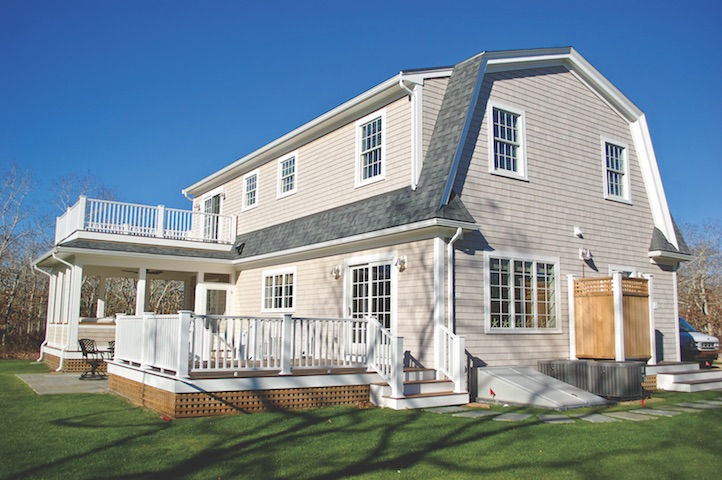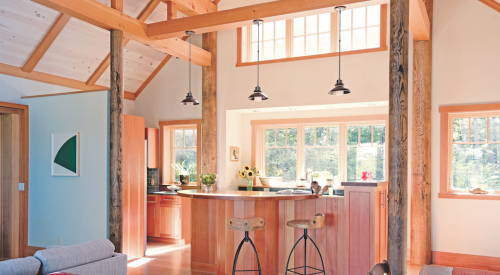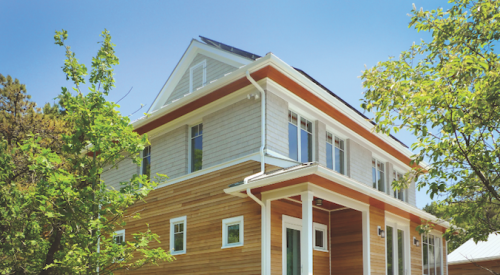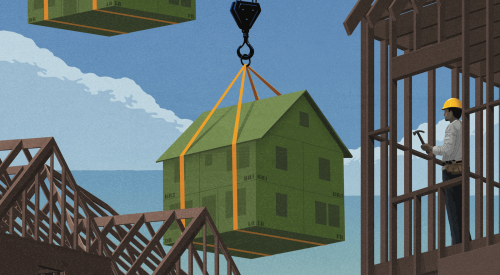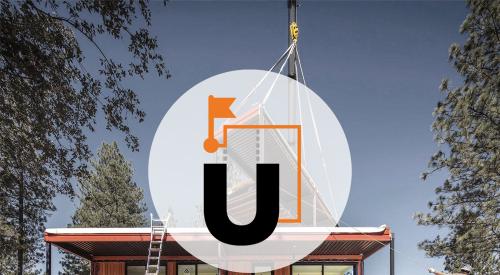Of the many arguments in favor of off-site fabrication, the most compelling may be its role as a solution to persistent labor shortages. Prefabricated housing takes less time to complete. In addition, it generates less on-site waste and it’s energy efficient, even complying with Passive House standards in some cases. And today’s prefabs have more design flexibility than ever.
While prefab housing includes roof and wall assemblies and components, modular construction involves the factory completion of entire sections, which are then delivered to the jobsite. With all the advantages of factory-built housing—both prefab and modular—it’s surprising more builders don’t use it. According to the U.S. Census Bureau, only about 2 percent of new single-family homes annually built in the U.S. are modular.
Yet some feel that change is in the air. “Across the board, I see prefabrication as a sign of maturity,” says Bill McDonald, founder and CEO of Phoenix Haus, a Detroit-based designer and builder of energy-efficient building systems. “It’s only a matter of time until all project sites integrate some form of factory-built component as it relates to the envelope.”
Bill Potter, owner and president of Squash Meadow Construction, in Vineyard Haven, Mass., has been building modular houses on Martha’s Vineyard for 11 years. It started in 2007 when he built a spec prefabricated by Westchester Modular Homes, in Wingdale, N.Y. That home was LEED Gold and sold for $1.2 million—a comparative bargain in a pricey real-estate market.
This video by Tom Bassett-Dilley Architect depicts the setting of modules for a home in Oak Park, Ill. The modules were prefabricated by Hi-Tech Housing, Bristol, Ind.
“I was looking for a company that could mimic the architecture of Martha’s Vineyard; produce [a home] that was the same quality as, if not superior to, what we were building on site; and was also green,” he says. “We sold that house for 20
Of the many arguments in favor of off-site fabrication, the most compelling may be its role as a solution to persistent labor shortages. Prefabricated housing takes less time to complete. In addition, it generates less on-site waste and it’s energy efficient, even complying with Passive House standards in some cases. And today’s prefabs have more design flexibility than ever.
While prefab housing includes roof and wall assemblies and components, modular construction involves the factory completion of entire sections, which are then delivered to the jobsite. With all the advantages of factory-built housing—both prefab and modular—it’s surprising more builders don’t use it. According to the U.S. Census Bureau, only about 2 percent of new single-family homes annually built in the U.S. are modular.
Yet some feel that change is in the air. “Across the board, I see prefabrication as a sign of maturity,” says Bill McDonald, founder and CEO of Phoenix Haus, a Detroit-based designer and builder of energy-efficient building systems. “It’s only a matter of time until all project sites integrate some form of factory-built component as it relates to the envelope.”
Bill Potter, owner and president of Squash Meadow Construction, has been building modular houses on Martha’s Vineyard for 11 years. It started in 2007 when he built a spec prefabricated by Westchester Modular Homes, in Wingdale, N.Y. That home was LEED Gold certified and sold for $1.2 million—a comparative bargain in a pricey real estate market.

This Colonial by Westchester Modular Homes is a seamless blend of modular construction and site finishes. In some cases, it’s more cost-effective for builders to add certain elements, such as porches, on the jobsite. (Photo: courtesy Westchester Modular Homes)
“I was looking for a company that could mimic the architecture of Martha’s Vineyard; produce [a home] that was the same quality as, if not superior to, what we were building on site; and was also green,” he says. “We sold that house for 20 percent less [than comparable homes on the island] and completed construction in three months.” From beginning to end, design, permitting, and construction took about seven months.
Potter builds approximately 12 homes a year for an annual volume of $6 million. His cost per square foot is around $300, which includes everything but landscaping and appliances. Finishes include mahogany decking, hardwood floors, ceramic tile, and granite countertops. “There’s no cheese in any of it,” he says. “It’s equivalent to a high-end home.”
For Squash Meadow’s projects, the boxes are shipped from Westchester’s Wingdale factory to New Bedford, Mass., then put on a barge that takes them across the sound to Vineyard Haven. There, trucks transport the modules to the site, and a crane, brought in from Cape Cod, sets them in place.
Potter says that Westchester can engineer a home to overcome certain design difficulties that have traditionally plagued modular manufacturers. “One example is cathedral ceilings,” he says. “Squash Meadow and Westchester work together as one team instead of two separate teams. Let’s say that during the engineering phase, we find out we’re going to need some steel for the ceilings. Instead of having it done in the plant, we make sure the steel is on site when the modules are delivered so it can be incorporated into the set.” He continues, “It’s kind of a hybrid approach. Because it takes advantage of factory capabilities as well as the builder’s skills, there’s very little we can’t do.”
Squash Meadow also has done a few commercial projects on Martha's Vineyard, including apartments, a 10,000-square-foot addiction treatment center, and an arts center. But it’s the residential work that captures what the company is all about, Potter says.
The home shown on pages 44-45 is a gambrel-style Colonial, based on a photo of a house the client brought to Squash Meadow. The 2,700-square-foot home “would have cost a crazy amount” to stick build, Potter says, adding, “Here on the island, community and clients can be very particular about look and feel. This home is a seamless fit with the surrounding area.”
What Modular Can and Can’t Do
Oak Park, Ill., architect Tom Bassett-Dilley, AIA, chose Hi-Tech Housing, of Bristol, Ind., for his first modular project for three reasons: the company’s expertise in custom prefab; experience with high-performance, passive buildings; and a low-toxicity protocol. “They made it clear that they could do what we needed to do,” Bassett-Dilley says. That said, not everything is possible with modular; some facets of a project may not pencil out.
“I did a house in Springfield, Ill., that was sort of wedge-shaped—very tall on one side,” Bassett-Dilley says. For that, the factory would have had to break up the upper parts into a big wedge and build a temporary floor as bracing so that the house could be moved over the highway. “At the site, they would have had to cut the temporary floor out, so there would be wasted material,” he says.

Six modular units by Hi-Tech Housing comprise this home in Oak Park, Ill. Note the lack of on-site waste. (Photo: Tom Bassett-Dilley Architect)
Some sites are simply not accessible with a tractor-trailer and a crane. Bill Potter of Squash Meadow Construction on Martha’s Vineyard had to stick-build one house “because we couldn’t get the boxes down the road.”
Doug Mills, manager at Hi-Tech Housing, says it’s a question of what makes sense to both the manufacturer and the builder. “Someone may want a design where the roof has to fold down for shipping, and we can’t get it to fold properly in the factory,” he says. “In that case, it may make more sense to ship the roof separately in its own container, or even build it on site.”
Prefab Passive House
When Tom Bassett-Dilley, built his first modular home last year, he was impressed by how well the technology lends itself to passive-building practices. Hi-Tech Housing prefabricated the modules for Bassett-Dilley’s project: a 2,000-square-foot two-story home. The structure is composed of six modules.
“Passive House is performance-driven, so there are a lot of ways of getting there," Bassett-Dilley says. "What we were really pleased about is that after the modules were set, we did a blower-door test, and the result exceeded Passive House requirements for new construction. The quality control in the factory really did pay off.” The airtightness of wall-to-ceiling transitions is particularly difficult to achieve, he notes, “but Hi-Tech just nailed it.”


The Artisans Group designed the template for the 1,931-square-foot low-slung, modern Vogel Haus (top and above). Phoenix Haus crafts the home in its factory with wall, floor, and roof assemblies that comply with Passive House standards. (Photos: Poppi Photography)
Architect Tessa Smith, AIA, principal of Artisans Group, in Olympia, Wash., recently began working with Phoenix Haus on prefabricated walls, floors, and roofs for Passive Houses. “We tried doing our own prefab walls, but we didn’t have enough volume [to justify building a factory],” Smith says.
Phoenix Haus prefabricates foam-free wall and roof assemblies designed and built to the Passive House standard, and delivers the exterior walls with triple-pane windows and air sealing already installed.
Along with several other architects in the Portland, Ore., area and Washington state, Artisans Group has designed “plug-and-play” templates that are priced out and available for purchase on the Phoenix Haus website.
The Phoenix Haus system “is great for builders or architects who are daunted by the idea of building their first Passive House,” Smith says. “The hardest part is the shell, [and we] make that easy for them.” Phoenix Haus also sends a representative to each construction site to help put the home together and make it airtight.
Artisans Group is currently building a Passive House in Seattle on a steep, urban site with poor access. “Prefab makes a lot of sense for that, too, because you don’t have a framing crew with [materials] that need to be dropped in and stored somewhere,” Smith notes. She points out that construction involves scheduling a day to install all walls with a crane, as opposed to weeks for a conventional framing crew. "We don't see a downside," she says.
To date, Phoenix Haus has sold four template houses. McDonald projects a 300 increase in business in the coming year.
The BMW of Modular
According to manager Doug Mills, Hi-Tech produces about 100 units a year. “We consider ourselves a custom modular manufacturer,” he says. “It goes beyond making minor modifications.” Customers can select from pre-engineered designs with optional features such as cross gables, dormers, and bay windows, and Hi-Tech will modify the plans as desired. Designs are divided into individual sections that can be safely and legally transported from the factory to the building site.
Jamie Mackay tried to sell planning officials in Jackson Hole, Wyo., on an affordable housing development in 2007. After the project was mothballed, Mackay built modular cabins on wheels in an RV park he owned. Thus Wheelhaus was born: a designer and manufacturer of modular homes ranging from 400 to 2,500 square feet.
He likes to think of Wheelhaus as the BMW of modular: “We’re not the cheapest; we’re not the most expensive.” He avoids customization because it would make the cost of the homes prohibitive. “We already know our architecture looks good and meets snow- and wind-load requirements in 47 states.”


The Wedge (top and above), by Wheelhaus in Jackson Hole, Wyo., is a 400-square-foot home that expands the perception of space with high ceilings and large trapezoid windows. The house features siding made with reclaimed Wyoming snow fencing. (Photos: courtesy Wheelhaus)
Wheelhaus is doing more business with developers these days. The company is building 120 cabins for a resort in Montana and recently submitted proposals for new master planned communities in Colorado and Utah. The Colorado project will consist of 500 units ranging from 600-square-foot cabins to 2,000-square-foot houses.
Mackay recently introduced a collection of 400-square-foot tiny homes, most with good-size decks to expand living space. There are eight models, all with a rustic/modern aesthetic, high ceilings, oversize windows, 8-foot-tall doors, and reclaimed wood inside and out. Most of the homes are placed on permanent foundations.
More Modular and Prefab in Multifamily
Going forward, modular and prefabricated housing is expected to have more of an impact on the multifamily sector. Modular is often mentioned as an affordable housing solution, which would mean larger projects of several hundred units or more. Presently the method is more applicable to smaller buildings.
“Most of what we do is single-family, but we’ve seen a pickup over the last few years in small townhouse projects,” says John Colucci, president of Westchester Modular Homes. Colucci has noticed more builders putting up apartment buildings of, perhaps, four units that they maintain for rental income.
Between 2005 and 2006, the average house produced by Westchester was 400 to 500 square feet larger than it is now. “But sales are up and activity is up,” he says. “Our open houses are well attended. [Buyers] are finally jumping off the fence.”
Nearly every home that rolls off Westchester’s assembly line has been customized to some degree.
Builder clients are usually small to medium size, typically building five to 30 homes per year. Attuned as they are to energy efficiency, they’re pleased to be able to report impressive HERS ratings to their customers, Colucci says.
